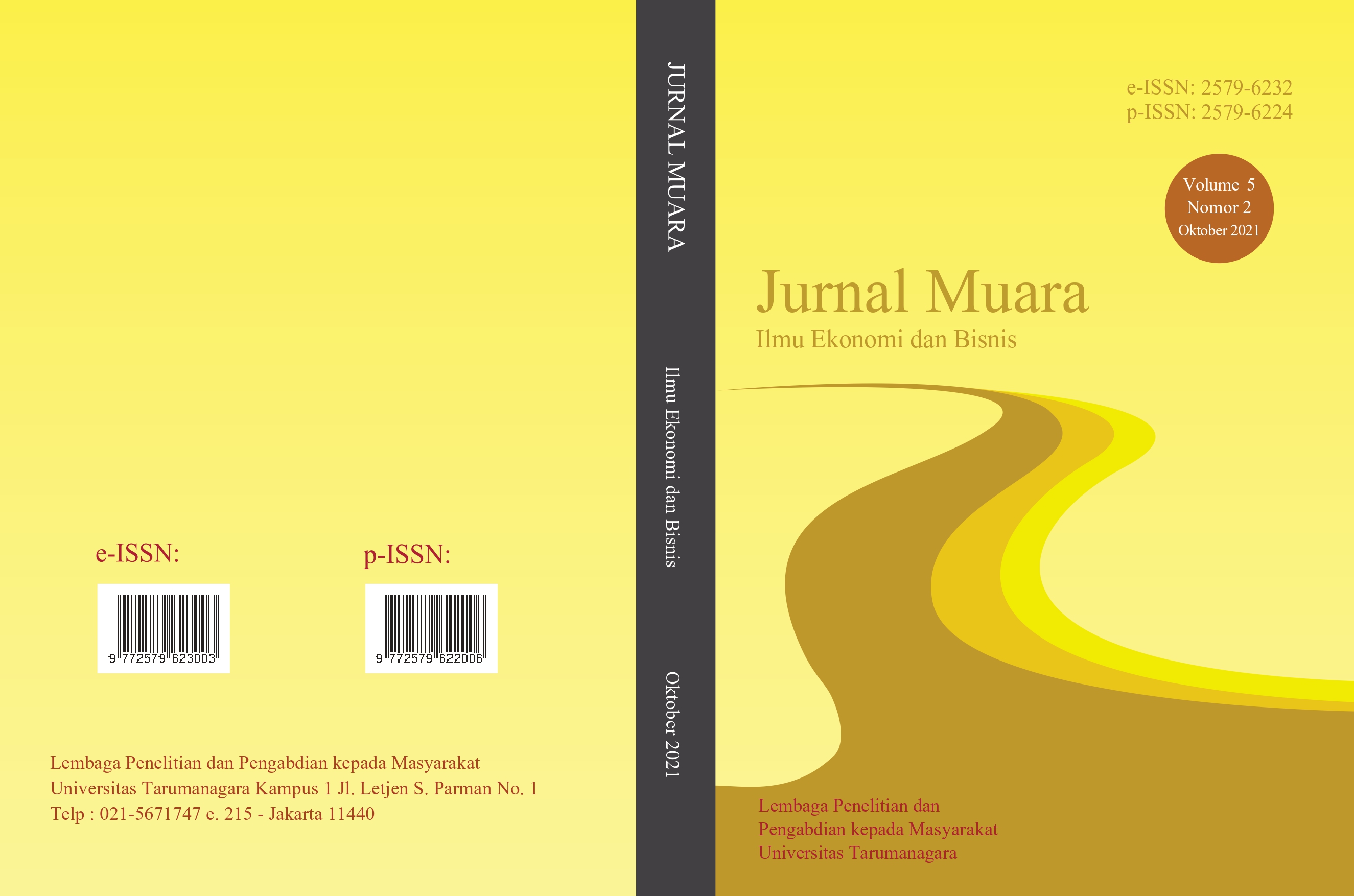THE INFLUENCE OF COUNTRY OF ORIGIN TOWARDS BRAND EQUITY DIMENSIONS AND PURCHASE INTENTION OF CHINESE SMARTPHONE BRAND
Main Article Content
Abstract
Penelitian ini bertujuan untuk mengetahui: pengaruh negara asal terhadap dimensi ekuitas merek dan niat beli merek smartphone Cina yaitu Xiaomi. Variabel yang digunakan dalam penelitian ini adalah: negara asal, kesadaran merek, asosiasi merek, loyalitas merek, persepsi kualitas, dan niat beli. Penelitian ini menggunakan metode kuantitatif dengan metode convenience sampling. Pengumpulan data dalam penelitian ini menggunakan data primer dengan menyebarkan kuesioner kepada 302 responden yang pernah menggunakan smartphone chines. Teknik analisis data dalam penelitian ini menggunakan Structural Equation Model (SEM) dengan software SmartPLS 3.0. Berdasarkan analisis yang telah dilakukan, hasil penelitian ini menunjukkan (1) terdapat pengaruh yang signifikan dari negara asal terhadap kesadaran merek, asosiasi merek, loyalitas merek dan persepsi kualitas. (2) Terdapat pengaruh yang signifikan antara kesadaran merek, loyalitas merek, dan persepsi kualitas terhadap niat beli. (3) Tidak terdapat pengaruh yang signifikan antara negara asal dan asosiasi merek terhadap niat beli.
This study aimed to find out: the influence of country of origin towards brand equity dimensions and purchase intention of Chinese smartphone brand which is Xiaomi. The variables that used in this study are: country of origin, brand awareness, brand association, brand loyalty, perceived quality, and purchase intention. This study used quantitative methods with convenience sampling method. Data collection in this study used primary data by distributing a questionnaire to 302 respondents who are ever use chines smartphone. The data analysis technique in this study used Structural Equation Model (SEM) with SmartPLS 3.0 software. Based on the analysis that has been done, the result of this study shows (1) there are significant influence of country of origin on brand awareness, brand association, brand loyalty and perceived quality. (2) There are significant influence of brand awareness, brand loyalty, and perceived quality towards purchase intention. (3) There are no significant influence of country of origin and brand association towards purchase intention.
Article Details
Section
References
Aaker, D. A., & Equity, M. B. (1991). Capitalizing on the Value of a Brand Name. New York, 28(1), 35-37.
Abdillah, W. (2015). Jogiyanto. (2015). Partial least square (PLS) alternatif structural equation modeling (SEM) dalam Penelitian Bisnis, 225-255.
Alam, S. S., Senik, Z. C., Omar, N. A., & Ali, M. H. (2018). Consumer-based brand equity: Relationship between country of origin and brand equity dimension. Jurnal Pengurusan (UKM Journal of Management), 53.
Almohaimmeed, B. M. (2019). The Effects of Social Media Marketing Antecedents on Social Media Marketing, Brand Loyalty and Purchase Intention: A Customer Perspective. Journal of Business and Retail Management Research, 13(4).
Artaji. (2014). Pengaruh Ekuitas Merek Terhadap Minat Pembelian. Jurnal Fakultas Ekonomi Universitas Negeri Yogyakarta, 11-34.
Berlianto, M. P. (2019). Pengaruh Country of Oringin Dan Brand Image Terhadap Brand Equity Dan Niat Pembelian Pada Produk Kosmetik. Journal of Business & Applied Management, 12(01).
Indonesia Smartphone Market Sales Register 20% YoY Decline in Q2 2020, Online Market Share Hits All-time High of 19%. (2020). Retrieved from https://www.counterpointresearch.com/: https://www.counterpointresearch.com/indonesia-smartphone-market-q2-2020/
Gabriella, G., & Sonny, S. (2021). The Impact Of Brand Equity To Purchase Intention (Case Study From Iphone Users In Makassar). Jurnal Muara Ilmu Ekonomi dan Bisnis, 5(1), 1-11.
Jogiyanto, H. M., & Abdillah, W. (2009). Konsep dan aplikasi PLS (Partial Least Square) untuk penelitian empiris. BPFE Fakultas Ekonomika dan Bisnis UGM. Yogyakarta.
Jokhu, J. R., & Armando, A. (2019). Perspektif Baru dalam Teori Kualitas Pelayanan: Pentingnya Intensi Studi pada Perusahaan Fintech di Indonesia. Manajemen Bisnis Kompetensi, 13(2).
Karina, N. (2015). The Influence of Brand Equity toward Purchase Intention (A Case Study: Karstu AS GSM Sim Card Provider among the Students at President University). Doctoral Dissertation, President University.
Keller, K. L. (1993). Conceptualizing, measuring, and managing customer-based brand equity. Journal of marketing, 57(1), 1-22.
Kotler, P., & Keller, K. L. (2012). Marketing Management 14E. New Jersey: Pearson Prentice Hall.
Kreppel, H., & Holtbrügge, D. (2012). The perceived attractiveness of Chinese products by German consumers—A sociopsychological approach. Journal of Global Marketing, 25(2), 79-99.
Liu, H. H., & Wang, Y. N. (2019). Interrelationships between viral marketing and purchase intention via customer-based brand equity. Journal of Business and Management Sciences, 7(2), 72-83.
Manojkumar, S. S., & Sharma, D. M. S. (2018). An Empirical Study to Measure the Effect of Brand Loyalty and Skepticism on Purchase Intention with Reference to Cause Related Marketing in Ahmedabad City. Journal of Management, 5(2).
Menon, V. P., & Barani, G. (2016). Dimensions of brand equity: An investigation on higher education institutions. Asian Journal of Research in Social Sciences and Humanities, 6(5), 353-359.
Purwanto, E., & Wibisono, A. (2019). Pengaruh Country of Origin, Word of Mouth, Kualitas Yang Dipersepsikan Terhadap Niat Beli: Study Pada Kamera Digital Merek Jepang. Jurnal Riset Manajemen dan Bisnis (JRMB) Fakultas Ekonomi UNIAT, 4(3), 365-374.
Roscoe, B. A., Hopke, P. K., Dattner, S. L., & Jenks, J. M. (1982). The use of principal component factor analysis to interpret particulate compositional data sets. Journal of the Air Pollution Control Association, 32(6), 637-642.
Sarwono, J., & Narimawati, U. (2015). Membuat Skripsi, Tesis, dan Disertasi dengan Partial Least Square SEM (PLS-SEM). Yogyakarta: ANDI.
Sekaran, U., & Bougie, R. (2016). Research methods for business: A skill building approach. John Wiley & Sons.
Shahrokh, Z. D., & Azodi, A. D. (2013). The effect of country of origin image on brand equity and purchase intention. Journal of Applied Environmental and Biological Sciences, 3(12), 52-61.
Smartphone. (2021). Retreived from computerhope.com: https://www.computerhope.com/jargon/s/smartphone.htm
Srikatanyoo, N., & Gnoth, J. (2002). Country image and international tertiary education. Journal of Brand Management, 10(2), 139-146.
Usman, O., & Aryani, Y. (2019). The Effect of Brand Ambassador, Brand Image, Product Quality, and Price on Purchase Intention. Brand Image, Product Quality, and Price on Purchase Intention (December 31, 2019).
Wicaksana, S. N. (2018). Analisis Perbedaan Persepsi Konsumen terhadap Merek Smartphone China dan non China. Universitas Sanata Dharma, obtained from: http://repository.usd.ac.id/31371/2/142214202_full.pdf
Yunus, N. S. N. M., & Rashid, W. E. W. (2016). The influence of country-of-origin on consumer purchase intention: The mobile phones brand from China. Procedia Economics and Finance, 37, 343-349.

